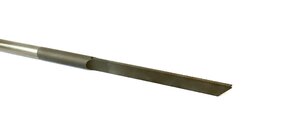Leaf and coil springs from vehicles are used a lot for edge tools.
I saw a basic Blacksmiths guide intended for the third world many years ago and all the tools were made from it.
Silver steel rod is commonly available over here as is ground flat stock. Both are good for edge tools. I recently milled a beading tool from Silver steel and it works well. I tempered the whole tool to help prevent it snapping in use. I frequently though leave the very tip of cutting tools “glass hard” and I’ve not had any issues. Some high carbon tool steels have a Rockwell hardness similar to HSS if left like this. They don’t have the wear resistance of HSS but for some tools this isn’t too much of an issue.
This is the Beading tool.

I saw a basic Blacksmiths guide intended for the third world many years ago and all the tools were made from it.
Silver steel rod is commonly available over here as is ground flat stock. Both are good for edge tools. I recently milled a beading tool from Silver steel and it works well. I tempered the whole tool to help prevent it snapping in use. I frequently though leave the very tip of cutting tools “glass hard” and I’ve not had any issues. Some high carbon tool steels have a Rockwell hardness similar to HSS if left like this. They don’t have the wear resistance of HSS but for some tools this isn’t too much of an issue.
This is the Beading tool.


